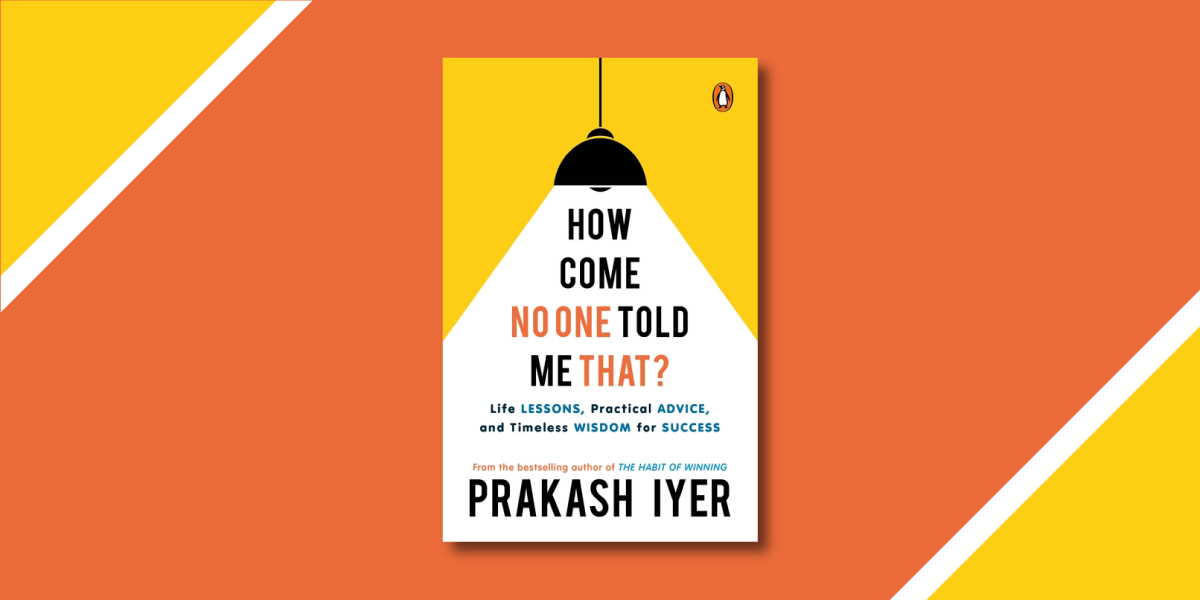
Your education teaches a lot, but it doesn’t quite prepare you for the larger game of life. Does it? Prakash Iyer’s How Come No One Told Me That? is a cornucopia of stories that can help you lead a life of purpose and significance. The small and seemingly unimportant experiences of your life can teach you many valuable lessons and Iyer’s book is a collection of such anecdotes and everyday events.
Here’s an excerpt from the book about the white handkerchief of the chairman of Hindustan Unilever. It’s a story that’s been retold to successive generations of young managers at the company. It’s a reminder for all to fix a problem when they see it.
*

How Come No One Told Me That?
Prakash Iyer
The chairman of Hindustan Unilever was on a market visit in a small town in Kerala. At one store, he noticed a tin of Dalda (a popular brand of vanaspati at that time) on a corner shelf. As he reached out to take a closer look at the tin, he was horrified to see a thick layer of dust on the lid. There were sheepish looks on the faces of the folks accompanying the chairman. It wasn’t something they wanted the chairman to see. The sales team’s routine included cleaning stocks on the shelf—with particular attention to food products. This was a bad miss.
And what did the chairman do? Scream and shout? Threaten to sack someone? Talk about the need for better execution? Nope.
He put his hand into his trouser pocket, pulled out a clean, white handkerchief and proceeded to wipe the Dalda tin clean. That was it. He did what any foot soldier of the company might have done. It was about getting a job done, rather than worrying about whose job it was.
The sales team got the message, of course. Far better than they might have had the chairman shown anger and disappointment. The retailer’s respect for the company went up a few notches in that instant too. All those present that day got a masterclass in leadership. And as the story got retold over the years, young managers began to understand what a leader’s work ethic ought to be. And what great leadership looks like.
I was reminded of the Dalda and the handkerchief story once again several decades later. I was in a meeting with the managing director of a large auto ancillary company. With him was his head of Learning and Development. We sat around a little roundtable at their guesthouse. As the L&D head began the discussion, I saw the managing director get up and go into the kitchen. And he was back in a jiffy, with a cleaning cloth in his hand. He then went on to wipe the table clean. And as he saw the look of surprise on our faces, he said that when he put his diary on the table, he figured the table was dusty, and so he decided to clean it.
Now this is such a rare sight, I thought to myself. When was the last time you saw the managing director of a company actually take a mop out and clean a table—in front of a group of other people?
Think about it. He could have so easily done something else. He could have called out to the attendant, who at that stage was busy making some tea and coffee for us, and said, ‘Come, I want you to clean the table right now!’ Or he could have shouted at him for not having maintained a clean table. Or he could have complained about the world we live in and said, ‘Look, there’s so much dust around us!’ He didn’t do any of those, for he was a man who had seen a problem (which none of us had actually noticed) and then decided, ‘Hey, let me do something about it!’ He went out, got a cloth and cleaned the table.
Great leaders are like that.
It is the kind of leadership that’s becoming so rare to find in our world today. And it’s also the kind of leadership that we all need to see more of. And show more of.
The chairman did it. The managing director did it. What’s stopping you? What’s your excuse? The next time you see a problem—when you see dust on the table or on your company’s products—which nobody else has noticed, don’t leave it there. Don’t shout. Don’t ask someone to set it right. Take a cloth and clean it!
Not only will you have a clean table—and clean products—but you’ll also become a role model for others, exemplifying what great leadership looks like.
And, many years later, they will still be telling your story.
**
Read How Come No One Told Me That? to think clearly, take better decisions, learn lessons, become a better leader and a better person in life.









